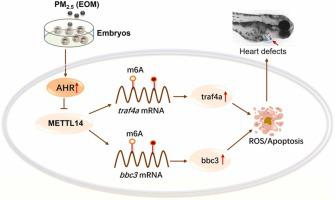Journal of Hazardous Materials ( IF 13.6 ) Pub Date : 2023-06-02 , DOI: 10.1016/j.jhazmat.2023.131749 Cheng Ji 1 , Yizhou Tao 1 , Xiaoxiao Li 2 , Jin Wang 2 , Jin Chen 2 , Stanley Aniagu 3 , Yan Jiang 1 , Tao Chen 2

|
A growing body of evidence indicates that ambient fine particle matter (PM2.5) exposure inhibits heart development, but the underlying mechanisms remain elusive. We hypothesized that m6A RNA methylation plays an important role in the cardiac developmental toxicity of PM2.5. In this study, we demonstrated that extractable organic matter (EOM) from PM2.5 significantly decreased global m6A RNA methylation levels in the heart of zebrafish larvae, which were restored by the methyl donor, betaine. Betaine also attenuated EOM-induced ROS overgeneration, mitochondrial damage, apoptosis and heart defects. Furthermore, we found that the aryl hydrocarbon receptor (AHR), which was activated by EOM, directly repressed the transcription of methyltransferases mettl14 and mettl3. EOM also induced genome-wide m6A RNA methylation changes, which led us to focus more on the aberrant m6A methylation changes that were subsequently alleviated by the AHR inhibitor, CH223191. In addition, we found that the expression levels of traf4a and bbc3, two apoptosis related genes, were upregulated by EOM but restored to control levels by the forced expression of mettl14. Moreover, knockdown of either traf4a or bbc3 attenuated EOM-induced ROS overproduction and apoptosis. In conclusion, our results indicate that PM2.5 induces m6A RNA methylation changes via AHR-mediated mettl14 downregulation, which upregulates traf4a and bbc3, leading to apoptosis and cardiac malformations.
中文翻译:

AHR介导的m6A RNA甲基化导致PM2.5诱导斑马鱼幼虫心脏畸形
越来越多的证据表明,环境细颗粒物 (PM 2.5 ) 暴露会抑制心脏发育,但其潜在机制仍然难以捉摸。我们假设 m 6 A RNA 甲基化在 PM 2.5的心脏发育毒性中发挥重要作用。在这项研究中,我们证明,PM2.5 中的可提取有机物 (EOM) 显着降低了斑马鱼幼虫心脏中的整体 m 6 A RNA 甲基化水平,而甲基供体甜菜碱可恢复这一水平。甜菜碱还可以减轻 EOM 诱导的 ROS 过度生成、线粒体损伤、细胞凋亡和心脏缺陷。此外,我们发现芳烃受体(AHR)被 EOM 激活,直接抑制甲基转移酶mettl14和mettl3的转录。EOM 还诱导全基因组 m 6 A RNA 甲基化变化,这使我们更加关注异常的 m 6 A 甲基化变化,这些变化随后被 AHR 抑制剂 CH223191 缓解。此外,我们发现两个凋亡相关基因traf4a和bbc3的表达水平被EOM上调,但通过mettl14的强制表达恢复到控制水平。此外,敲除traf4a或bbc3可以减弱 EOM 诱导的 ROS 过量产生和细胞凋亡。总之,我们的结果表明 PM2.5通过 AHR 介导的mettl14下调诱导 m 6 A RNA 甲基化变化,从而上调traf4a和bbc3,导致细胞凋亡和心脏畸形。


























 京公网安备 11010802027423号
京公网安备 11010802027423号